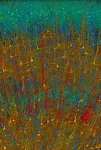(Press-News.org)
A research team led by the Keck School of Medicine of USC has discovered that a non-invasive eye exam may be a possible tool for screening Black Americans and other people from underdiagnosed and high-risk populations for cerebral small vessel disease, a major contributor to cognitive impairment and dementia. After Alzheimer’s disease, vascular dementia, associated with impaired blood flow to the brain, is the second most common dementia diagnosis.
“Most people with cerebral small vessel disease are not diagnosed until significant brain damage has occurred. Damage to the brain cells is not reversible.” said Xuejuan Jiang, PhD, associate professor of ophthalmology at the Keck School of Medicine and lead author of the study that was published in the journal Alzheimer's & Dementia: The Journal of the Alzheimer's Association. “This exam might help identify those people who are at high risk of developing cerebral small vessel disease early, while they can still get help.”
Using a new type of device that looks at the blood vessels in the retina, the team was able to connect certain characteristics in the vasculature of the eye to early signs of cognitive decline and structural changes commonly found in the brains of people with cerebral small vessel disease.
New imaging, new insights
Recruited from the African American Eye Disease Study, a population-based study of more than 6,000 African Americans from Inglewood, California, the research participants were all over 40 and had no history of cognitive impairment. Study participants underwent a type of retinal imaging called optical coherence tomography angiography, or OCTA, which was carried out at the USC Roski Eye Institute.
OCTA, a relatively new type of imaging that is increasingly incorporated in clinical practice in ophthalmology, captures detailed images of tiny retinal capillaries without needing to inject a dye into the patient. Using these images, the team was able to calculate the density of these blood vessels within the retina, the amount of blood that is flowing through those vessels and how quickly the blood was moving. Jiang noted that OCTA can capture changes in retinal capillaries before patients have clinical symptoms.
Participants were put through a series of examinations to evaluate their cognitive function. Some of them also underwent magnetic resonance imaging (MRI) of the brain which allowed the team to take measurements of the participants’ brain structures. Certain early structural changes in the brain are known biomarkers of cerebral small vessel disease.
A common connection
After analyzing the information collected during the exams, the team found that lower rates of blood flow through the retinal capillaries and lower density of blood vessels are both connected to functional and structural changes in the brain associated with cerebral small vessel disease.
Among people in the study who underwent cognitive testing, lower rates of blood flow and blood vessel density were connected to worse information processing speed and executive function. They were also associated with three MRI measures which are known to be related to cerebral small vessel disease.
“This indicates that altered retinal blood flow may be a biomarker of early changes in cognition resulting from cerebral small vessel disease,” said Jiang, noting that of the two associated measures, the rate of blood flow in the retinal capillaries was a more sensitive measure of changes in the brain. Jiang noted that this technology might also be used to monitor the progression of disease or the efficacy of treatments for cerebral small vessel disease.
Focus on diversity
It is also notable, said Jiang, that the study was carried out with Black participants because Black people typically have not been included in significant numbers in the research and clinical trials related to dementia and Alzheimer’s disease, despite dementia being more prevalent among Black people than white people in the United States.
It is critical that studies on cerebral small vessel disease and vascular dementia, noted Jiang, include diverse participants because these conditions are more commonly found among populations of people with high rates of diabetes, hypertension and other vascular diseases, which includes Blacks and Latinos.
“We know how important it is for research to include more diverse patients,” said Jiang. “There needs to be more research on Blacks and Latinos because they are at higher risk, and we are hopeful that this research is moving in the direction of finding a screening and monitoring tool.”
About the study
Additional authors of the study include Farzan Abdolahi, Victoria Yu, Lina M. D'Orazio, Chenyang Zhao, Kay Jann, and Danny J. Wang from the Keck School of Medicine of USC; Rohit Varma from the Southern California Eye Institute; Xiao Zhou and Ruikang K. Wang from the University of Washington; and Amir H. Kashani of Johns Hopkins University.
The research was supported by grants from the National Eye Institute (R21EY028721 and 3U10EY023575), the National Institute on Aging (R21EY028721S1), the National Institutes of Health (R01EY030564), the Brightfocus Foundation (CA2020004 and UF1NS100614) and unrestricted departmental funding from Research to Prevent Blindness to the University of Southern California and Johns Hopkins University.
END
In urban areas throughout the United States, it is imperative for all communities to have equal access to high quality parks. These parks can have many benefits for the physical and mental well-being of the residents who live in close proximity to the urban green spaces. For instance, they are a place to socialize and exercise outdoors while also providing vegetation nearby, which can help reduce urban heat.
Yet, in the City of Philadelphia, not all parks are created equal, according to a new study from the University of Delaware.
Using a machine learning algorithm to analyze 285 ...
The offspring of adolescent and young adult women with a history of cancer face a higher risk of birth defects, according to new research from UTHealth Houston.
A study led by Caitlin C. Murphy, PhD, MPH, associate professor of health promotion and behavioral sciences at UTHealth Houston School of Public Health, was published recently in Cancer Epidemiology, Biomarkers & Prevention.
“Concerns like the health of future children are at the top of mind for many young adults diagnosed with cancer, but they are already so overwhelmed at the time of diagnosis with ...
Intrusive thoughts, involuntary repetition of undesirable gestures and behaviors combined with high anxiety... Obsessive-compulsive disorder (OCD), a disabling condition, affects around 2% of the population, regardless of age. It is a strong vector of isolation since patients disproportionately focus on various obsessions—to the detriment of relationships, work, and leisure.
Treatment mainly consists of cognitive-behavioral therapy (CBT) that allows patients to readjust their thought patterns, combined with antidepressants. Unfortunately, the effects are slow to appear, and 30 to 40% of patients do not respond at all. “In this context, an option ...
Every year, over 15,500 Australians are diagnosed with bowel cancer, and it is the second leading cause of cancer deaths in the country. Over 1,700 (one in ten) of those diagnosed are young Australians aged under 50, and this incidence is increasing.
There is an urgent need to discover more effective treatments and improve bowel cancer screening, particularly for early-onset bowel cancer (those aged 25-49 years). Australians born in 1990 onwards have double the risk of developing bowel cancer compared with those born in 1950. These younger bowel cancer patients often have poorer outcomes as they typically present with late-stage ...
Patients with X-linked severe combined immunodeficiency disorder (SCID-X1), sometimes called “bubble boy disease,” are born with a defective gene that prevents them from producing immune cells. Gene therapy from St. Jude Children’s Research Hospital restored the immune system in multiple infants with SCID-X1 in 2019 by supplying copies of the corrected gene. Through ongoing efforts to monitor patient safety, St. Jude scientists recently documented where the gene copies integrate into patient DNA, providing a foundation to understand the biology and safety of using lentiviral vectors. The findings were published today in Science Advances.
“We ...
The human brain is a tangled highway of wires emanating from nearly 100 billion neurons, all of which communicate across trillions of junctions called synapses. “Depressingly complex,” Harvard neuroscientist Jeff Lichtman calls it. The only way to understand this highway, says Lichtman, is to create a map.
Lichtman, the Jeremy R. Knowles Professor of Molecular and Cellular Biology, has spent several decades generating such maps, and in doing so has pioneered a field known as “connectomics.” ...
A study published Oct. 4 in Gastroenterology further validates that pyrvinium, a drug that has been used for decades for intestinal pinworms, can be repurposed as a preventative treatment for stomach cancer.
Eunyoung Choi, PhD, assistant professor of Surgery, and colleagues have demonstrated in human organoids and mouse models that the drug induces cell death in precancerous lesions. Pyrvinium blockades both the MEK/ERK and STAT3 signaling pathways. In another study she led, which was published last year in Gastroenterology, the researchers demonstrated that pyrvinium blocked regeneration of dysplastic ...
Scientists have caught fast-moving hydrogen atoms – the keys to countless biological and chemical reactions – in action.
A team led by researchers at the Department of Energy’s SLAC National Accelerator Laboratory and Stanford University used ultrafast electron diffraction (UED) to record the motion of hydrogen atoms within ammonia molecules. Others had theorized they could track hydrogen atoms with electron diffraction, but until now nobody had done the experiment successfully.
The results, published October 5 in Physical ...
The Grand Canyon’s valleys and millions of years of rock layers spanning Earth’s history have earned it a designation as one of the Seven Natural Wonders of the World. But, according to a new UNLV and University of New Mexico study, its marvels extend to vast cave systems that lie beneath the surface, which just might hold clues to better understand the future of climate change — by studying nature’s past.
A research team led by UNLV paleoclimatologist and Professor Matthew Lachniet that included the University of New Mexico Department of Earth & Planetary Sciences Distinguished Professor Yemane Asmerom and Research Scientist Victor Polyak and other ...
Lugano, Switzerland, 6 October 2023 – Under the promise to “Disseminating innovative research for optimal cancer care” as this year’s tagline reads, the ESMO Congress 2023 will be held in Madrid between 20-24 October 2023 with a virtual component to allow as many people as possible to attend.
From a keynote lecture pinpointing the hallmarks of cancer in the current year through the reinforced commitment towards more academic input in the drug development process for better cancer care, and then further down to the dramatic scenarios brought by the too many situations of crisis in the world which have an unbearable impact ...





